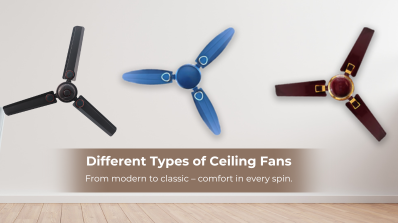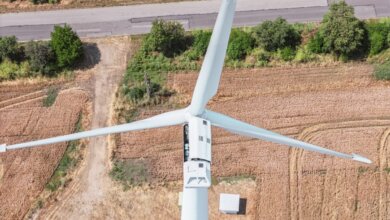Wallex Types of Ceiling Fans: How to Select the Best One?

Ceiling fans are more than just functional appliances — they are vital components of home ventilation, energy efficiency, and even interior design. Whether you live in a humid climate where constant air movement is a must or you simply want to reduce your air conditioning bills, choosing the right ceiling fan can make a big difference. With a broad variety of types available in the market, understanding each type of ceiling fan and how it fits your specific needs is essential for making the right choice.
This comprehensive guide explores the different types of fans and walks you through how to select the one that’s best for your space, lifestyle, and preferences.
Understanding the Role of Ceiling Fans
Before diving into the types, it’s important to understand what a ceiling fan does. A ceiling fan doesn’t lower the room temperature like an air conditioner; instead, it circulates air to create a cooling effect on your skin. The gentle breeze evaporates sweat, making you feel several degrees cooler. In colder months, reversing the fan direction can help circulate warm air, making your heating system more efficient.
With the right fan, you can enjoy year-round comfort while saving on energy costs.
Types of Ceiling Fans
Ceiling fans come in various designs, sizes, and functionalities. Let’s explore the most common and innovative types available today:
1. Standard Ceiling Fans
These are the most common type of ceiling fans and are found in a majority of homes and commercial spaces. They usually come with three to five blades and a built-in light fixture.
Key Features:
-
Mounted with a downrod
-
Available in a wide range of styles and finishes
-
Includes pull chains or remote controls
-
Designed for rooms with standard ceiling heights (8–10 feet)
Best For:
Living rooms, bedrooms, and dining areas with average ceiling height.
2. Low-Profile (Hugger) Ceiling Fans
Also known as flush-mount fans, these are designed for rooms with low ceilings — typically less than 8 feet in height. They don’t use a downrod and are mounted flush against the ceiling.
Key Features:
-
Space-saving design
-
Provides adequate air circulation in low-clearance areas
-
Often lacks lighting or advanced features
Best For:
Small bedrooms, apartments, basements, and attics.
3. Dual Motor Ceiling Fans
These fans come with two adjustable fan heads connected to a central motor housing. They provide both visual appeal and directional airflow, making them suitable for large or oddly shaped spaces.
Key Features:
-
Unique, stylish appearance
-
Independently adjustable fan heads
-
Excellent for wide air distribution
Best For:
Large hallways, patios, commercial lobbies, or unique interior themes.
4. Energy-Efficient (BLDC) Ceiling Fans
BLDC stands for Brushless Direct Current motor technology, a game-changer in ceiling fan engineering. These fans consume significantly less electricity without compromising on airflow.
Key Features:
-
Up to 65% more energy-efficient
-
Silent operation
-
Longer lifespan
-
Compatible with inverters and solar systems
Best For:
Eco-conscious homes, areas with frequent power outages, and energy-saving households.
5. Outdoor Ceiling Fans
Designed to withstand the elements, outdoor ceiling fans are ideal for patios, verandas, balconies, and other semi-exposed or fully open areas.
Key Features:
-
Weather-resistant materials (ABS plastic, stainless steel, sealed motors)
-
UL or IP rated for damp or wet conditions
-
Rust-proof coatings and blades
Best For:
Outdoor seating areas, sunrooms, pergolas, or poolside decks.
6. Remote-Controlled Ceiling Fans
Convenient and user-friendly, these fans come with remote controls allowing you to operate them without needing to use a wall switch or pull chain.
Key Features:
-
Multiple speed and light settings
-
Sleep timer and breeze modes
-
Wall-mounted or handheld remote units
Best For:
Modern homes, senior citizens, and those who prefer convenience.
7. Smart Ceiling Fans
A step beyond remote-controlled models, smart fans integrate with home automation systems. They can be controlled via mobile apps, Wi-Fi, voice commands (using Alexa, Google Assistant), or sensors.
Key Features:
-
App-based control and scheduling
-
Motion and temperature sensing
-
Integration with smart home ecosystems
-
Highly energy-efficient
Best For:
Smart homes, tech enthusiasts, and modern apartments.
8. Ceiling Fans with Lights
Combining functionality with design, these dual-purpose fans come with integrated lighting options, helping you save space and enhance room ambiance.
Key Features:
-
LED, halogen, or incandescent lighting
-
Dimmable and color-changing options
-
Available in both traditional and contemporary designs
Best For:
Bedrooms, kitchens, or any area where overhead lighting is essential.
9. Industrial Ceiling Fans
These are large, high-performance fans meant for warehouses, factories, and large commercial spaces. They’re designed to move large volumes of air over wide areas.
Key Features:
-
Large blades (60 inches or more)
-
Heavy-duty motors
-
High airflow (CFM)
-
Minimalist design focused on functionality
Best For:
Factories, warehouses, barns, gyms, or garages.
10. Retractable Blade Ceiling Fans
Also known as chandelier fans, these innovative models have retractable blades that extend when in use and hide when turned off, making them appear like standard light fixtures.
Key Features:
-
Hybrid design (fan + chandelier)
-
Remote-controlled
-
Stylish and space-saving
Best For:
Stylish apartments, dining rooms, and smaller spaces where décor matters.
How to Select the Best Ceiling Fan
Now that you’re familiar with the different types, here’s a practical guide to selecting the best ceiling fan for your space.
1. Consider the Room Size
Fan blade size directly affects performance and comfort. Here’s a basic guideline:
-
Up to 75 sq. ft.: 29″–36″ blade span
-
76–144 sq. ft.: 36″–42″
-
144–225 sq. ft.: 44″–50″
-
225–400 sq. ft.: 50″–60″
-
Over 400 sq. ft.: 60″+ or dual fans
Make sure the fan is proportionate to the room for optimal air circulation.
2. Evaluate Ceiling Height
-
For ceilings less than 8 feet: Use flush mount (hugger) fans.
-
For 8–9 feet: Standard downrod (3–5 inches).
-
For ceilings higher than 9 feet: Use extended downrods.
Ceiling fans should ideally hang 7–9 feet above the floor for best performance and safety.
3. Focus on Energy Efficiency
Choosing an energy-efficient fan can reduce electricity bills and your carbon footprint.
-
Look for BEE star-rated fans (India) or ENERGY STAR-certified models.
-
Consider BLDC motor fans for long-term energy savings.
-
Inverter-compatible fans can be a great asset during power cuts.
4. Match Your Style
Ceiling fans should complement the room’s décor. Here’s a quick matching guide:
-
Traditional Interiors: Wooden finish, classic blade designs, chandelier lights
-
Modern Interiors: Sleek designs, metal or matte finishes, minimalistic blades
-
Boho or Rustic Interiors: Natural wood, vintage-style motors, bronze tones
-
Kids’ Rooms: Colorful designs, cartoon themes, safer rounded blades
5. Decide on Lighting Needs
Ceiling fans with integrated lights can serve dual purposes but consider:
-
Room brightness: Will the fan light be the main light source?
-
Type of light: LED for efficiency, dimmable for ambiance
-
Compatibility with existing lighting systems
6. Evaluate Control Options
Choose a control system that suits your convenience:
-
Pull Chain: Traditional, simple to use
-
Wall Control: Good for children’s rooms or public spaces
-
Remote Control: Adds flexibility and ease
-
Smart Controls: Ideal for automated homes and voice-activated systems
7. Consider Indoor vs. Outdoor Use
Don’t use indoor fans in outdoor spaces—they’re not built for exposure to moisture or dust. Choose fans specifically rated for:
-
Damp areas: Covered patios or sunrooms
-
Wet areas: Fully exposed spaces like gazebos or pergolas
8. Check Noise Levels
A quiet fan enhances comfort, especially in bedrooms or offices. Fans with BLDC motors or specially designed blade pitches are quieter than traditional models.
Conclusion
The modern ceiling fan market offers a wide array of options, from basic utility models to high-tech smart fans that respond to your voice. Understanding the types of ceiling fans available — and knowing how each one serves different environments — can dramatically improve your comfort, aesthetics, and energy efficiency.
When choosing the best fan for your needs, always factor in room size, ceiling height, purpose, energy consumption, and design preferences. With careful consideration, you’ll not only find a fan that cools effectively but one that enhances your living space for years to come.




